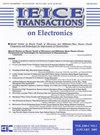Broadband port-selective silicon beam scanning device for free-space optical communication
IF 0.6
4区 工程技术
Q4 ENGINEERING, ELECTRICAL & ELECTRONIC
引用次数: 0
Abstract
SUMMARY Indoor free space optical (FSO) communication technology that provides high-speed connectivity to edge users is expected to be introduced in the near future mobile communication system, where the silicon photonics solid-state beam scanning device is a promising tool because of its low cost, long-term reliability, and other beneficial properties. However, the current two-dimensional beam scanning devices using grating coupler arrays have di ffi culty in increasing the transmission capacity because of bandwidth regulation. To solve the problem, we have introduced a broadband surface optical coupler, “elephant coupler,” which has great potential for combining wavelength and spatial division multiplexing technologies into the beam scanning device, as an alternative to grating couplers. The prototype port-selective silicon beam scanning device fabricated using a 300 mm CMOS pilot line achieved broadband optical beam emission with a 1 dB-loss bandwidth of 40 nm and demonstrated beam scanning using an imaging lens. The device has also exhibited free-space signal transmission of non-return-to-zero on-o ff -keying signals at 10 Gbps over a wide wavelength range of 60 nm. In this paper, we present an overview of the developed beam scanning device. Furthermore, the theoretical design guidelines for indoor mobile FSO communication are discussed.用于自由空间光通信的宽带端口选择性硅束扫描装置
为边缘用户提供高速连接的室内自由空间光学(FSO)通信技术有望在不久的将来被引入移动通信系统,其中硅光子固态光束扫描设备因其低成本、长期可靠性和其他有益特性而成为一种有前途的工具。然而,目前使用光栅耦合器阵列的二维光束扫描设备由于带宽的限制,在提高传输容量方面存在困难。为了解决这个问题,我们引入了一种宽带表面光耦合器,“大象耦合器”,它具有将波长和空分复用技术结合到波束扫描设备中的巨大潜力,作为光栅耦合器的替代品。采用300 mm CMOS导频线制作的端口选择性硅光束扫描装置原型实现了1 db损耗带宽为40 nm的宽带光束发射,并演示了使用成像透镜进行光束扫描。该器件还展示了在60 nm宽波长范围内以10 Gbps的速度传输不归零开关信号的自由空间信号。本文对研制的波束扫描装置进行了综述。在此基础上,讨论了室内移动FSO通信的理论设计准则。
本文章由计算机程序翻译,如有差异,请以英文原文为准。
求助全文
约1分钟内获得全文
求助全文
来源期刊

IEICE Transactions on Electronics
工程技术-工程:电子与电气
CiteScore
1.00
自引率
20.00%
发文量
79
审稿时长
3-6 weeks
期刊介绍:
Currently, the IEICE has ten sections nationwide. Each section operates under the leadership of a section chief, four section secretaries and about 20 section councilors. Sections host lecture meetings, seminars and industrial tours, and carry out other activities.
Topics:
Integrated Circuits, Semiconductor Materials and Devices, Quantum Electronics, Opto-Electronics, Superconductive Electronics, Electronic Displays, Microwave and Millimeter Wave Technologies, Vacuum and Beam Technologies, Recording and Memory Technologies, Electromagnetic Theory.
 求助内容:
求助内容: 应助结果提醒方式:
应助结果提醒方式:


